Democratic Kampuchea Was Defending Itself against Vietnamese Incursions, Witness Says
Civil Party Nget Chat concluded her testimony today. She provided information about the arrest of her first husband and her second wedding that was arranged by Angkar. Next, Civil Party Soy Saroeun took the stance and told the court about her arranged wedding. In the afternoon, witness Chuon Thi testified in relation to the armed conflict segment. He said that Vietnam had started the conflict and that Democratic Kampuchea was defending itself when counterattacking Vietnam.
Wedding
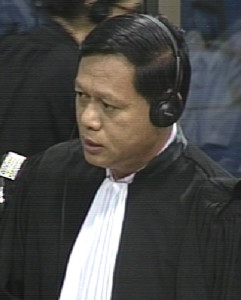
Civil Party Lawyer Lor Chunthy
The floor was granted to the Civil Party lawyers to continue putting questions to Nget Chat. Mr. Lor Chunthy asked how long she remained living in the cottage after the marriage with her new husband after her previous husband was killed. She replied that she could not recall how many days exactly, but said that it was only for a few days. “My husband was killed and I was so afraid I kept lying there and I noticed that militiamen were walking nearby.” She was afraid they would eavesdrop and hear her say something that would be considered as indicating that she was against the revolution.
On the day of the wedding, she was told not to go to work. She was sent to the read battlefield in Bang Khna. There were around ten couples, but she could not identify them, as it started being dark. The wedding started in the evening. Some people had arrived before her. Suon took her there. Suon was an organizer and went “back and forth” for the arrangement. She did not know the person, but “one Angkar” made an announcement that they were getting married and that they had to follow the instructions and were not allowed to protest. Her sister or brother did not attend the wedding, even if he or she was in the area. Neither did any other relatives attend the wedding. She could not recall the year, but “the announcement was made that it was in August 1978.” She did not know the actual month or year.
Arrest of Her First Husband
“My body shook […], however, I did not dare to weep”, she told the court. “I almost fainted.” Her husband wanted her to go with him to collect corn, but her child wanted to stay with her. She was questioned why she was at a specific location and was told that she should not follow her husband. She wanted to visit him a few days later when she was with her mother, but she was not allowed. After her husband was taken away, she was led to another location. She was asked to sleep at the new location with her two children. She did not sleep during the night and saw militiamen with swords.
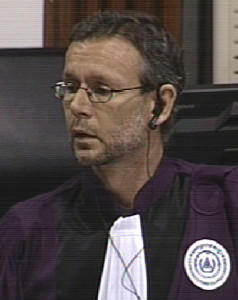
Senior Assistant Prosecutor Vincent de Wilde
There were around twenty people who were led away with her husband. Mr. Chunthy asked her to tell the Chamber about her pain and suffering. “I told my children that it was a great misery and it stays inside me. Even at the moment, I have a heart problem.” She said that she almost stops breathing every time she thinks about her husband being taken away.
After the Wedding
The floor was handed to the Co-Prosecution. Senior Assistant Prosecutor asked about her statement, in which she had said that she had told Rem that she would not get married again.[1] She recounted that Rem was sent away later. Some females from Svay Rieng liked her to be their chief. “I told them about my background and I said that I was also a 17 April Person.”
Mr. de Wilde asked how they organized the wedding so quickly after her first husband had been taken away. He wanted to know why it was important to remarry her so quickly. She replied that a cadre organized the wedding for her.
She was told to consummate her marriage. “How could I do that? I was so skinny,” she said. They were told that they needed to do this “so that Angkar would have a stock of children.” She knew that her sibling-in-law was in the youth unit and was also arranged to get married. “I told y sibling in law to work hard and to refashion oneself in order to survive, but my sibling-in-law was killed.”
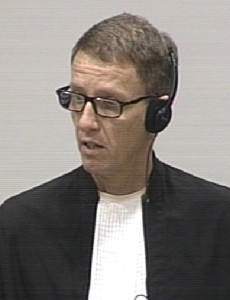
Nuon Chea Defense Counsel Victor Koppe
She got married with her first husband in 1971 and had two children until 1974. Her husband was a Khmer Krom. She did not know about the background of her father-in-law, but knew that her husband was born in Kampuchea Krom. He did not have an ID card. Khieu Samphan Defense Counsel objected and said that the treatment of the Khmer Krom was outside the scope of the trial. Mr. de Wilde said that it was important for the Civil Party. International Civil Party Lead Co-Lawyer Marie Guiraud said that the Chamber had issued a decision that some of the victims would be Khmer Krom and that the only issue that was excluded was genocide and persecution individually and that evidence in general was still admissible.[2] Nuon Chea Defense Counsel Victor Koppe said that the decision was clear to exclude the targeting of Khmer Krom. Moreover, Ieng Sary himself was Kampuchea Krom and that he therefore did not understand how where someone came from tied into the persecution of the Vietnamese. Ms. Guiraud wanted to respond, but was cut off. Ms. Guissé said they were in a civil law jurisdiction and that they had to “clinch this issue”, as this would impact the closing briefs. Mr. de Wilde replied that he had not asked his question yet. He then said that it was relevant whether Khmer Krom were perceived as Vietnamese. The objection was overruled.
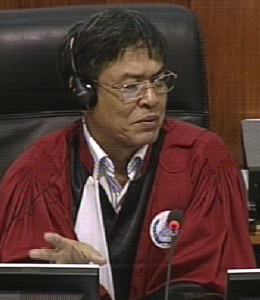
Presiding Judge Nil Nonn
Mr. de Wilde asked whether she knew whether the Khmer Krom were perceived as Vietnamese and what they were accused of. At this point, Mr. Koppe objected: “This is such a wrong question on so many levels.” He said it was asking for speculation and that the term “the Khmer Rouge” was inappropriate. The objection was sustained. The president informed the Co-Prosecution that their time had expired and the floor was handed to the Nuon Chea Defense Team.
First Marriage
Defense Counsel Liv Sovanna asked about her first marriage. She told the court that she was married when she was 15, since her mother had heard that girls were going to be arrested and therefore arranged for her to get married. She knew her husband for a long time already. Mr. Sovanna quoted her statement, in which she had said that she would be killed if she opposed.[3] She replied that she “refused” but did not dare to protest openly. “I accepted to do it, because I was afraid.” Comrade Rem was part of the committee of the battlefield. She only knew him and no other cadres.
She knew another cadre who was called Rim and not Rem. “They told me that if I refused, I would be sent to the upper level.”
Mr. Sovanna asked about her statement that she was sent to Prey Chhit.[4] She replied that she forgot some of the answers. She worked at this location. She said that she “refused secretly” when she was arranged to get married. Mr. Sovanna said that she had said that she had refused and was then sent to Prey Chhit. She recounted that she did not have sufficient food to eat during the regime. Her friends persuaded her to get married.[5] They said “you cannot oppose. [..] You have children, you should think about their destiny.” Her friends Comrade Pa and Comrade Mat talked to her about the wedding. Comrade Rym persuaded her to get married. With this, Mr. Sovanna concluded her line of questioning.
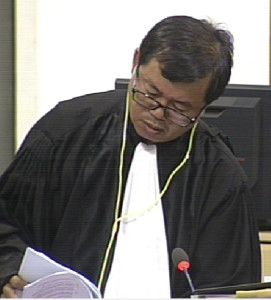
Khieu Samphan Defense Counsel Kong Sam Onn
Khieu Samphan Defense Counsel Kong Sam Onn asked whether she got married to her second husband around four or five days after her husband had been taken away or longer than that. she said it was four or five days after. Mr. Sam Onn read out her statement, in which she had said that it was 20 days after her husband was taken away.[6] She replied that she only gave an estimate. “It was not long after he was taken away to be killed.” She said it was only a few days after. At this point, Mr. Sam Onn concluded his questioning. Her colleague asked her about her position in the unit. She replied that she was a squad leader and not a unit leader. She could not recall who assigned her to that position. She did not know other leaders than two cadres. She did not know the people at the higher level well. Asked whether she considered the unit leaders as Khmer Rouge, she replied that they gave them instructions.
My husband was Khmer Krom, he did not make any mistake and he was sent for refashioning. […] Somehow he was taken away and killed. I pitied my husband the most. Even last night, when I recalled what happened, it seemed like he was still with me.”
At this point, the President adjourned the hearing for a break.
New Civil Party: Soy Naroeun
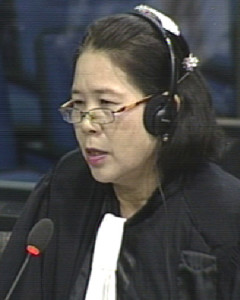
Civil Party Lawyer Sin Soworn
Soy Naroeun was born on 7 August 1955. Svay Teap Village, Chamkar Leu District, in Kampong Cham. Civil Party Lawyer Sin Soworn started putting questions to the Civil Party. On 17 April 1975, she was evacuated from Svay Teap Village to Au Luong Commune. She was separated from her family then. She worked in a mobile unit with around 20 to 30 women. “The working condition was terrible. The living condition was terrible.” They received ten tins of rice for each unit of 20 to 30 women. “I felt upset and worried. I was separated from my parents.” She got married in 1975. She was in the female mobile unit. One day, she was called to join the assembly meeting at Au Tma Village. Her unit chief told her to wear a skirt instead of pants and she wore a krama. She saw men sitting in one row and women in another. There were people from a committee, who asked them to make a commitment. Each couple had to make a commitment. “My body trembled.” None of her relatives attended the ceremony. “How could my parents know about this?” Sixty couples attended the ceremony, two of which were from her village. She described her experience as “painful”, since her parents did not attend the wedding and she did not know her husband before the wedding. “We were paired up like the way they pair up animals.” They loved each other only “when we had prior relationships with each other.” There were shelters that were built for the newly wed couples. They had thatched roofs and walls. They were brought to one of the buildings. She heard footsteps walking back and forth. She saw between six and seven militiamen walking back and forth. She saw a militiamen around fifty meters away from her shelter. “I saw two militiamen took a couple away from the shelter.” Half an hour later, she saw the militiamen coming back, but the couple did not return. She concluded that perhaps the couple did not get along way and that this was why they were taken away. A few minutes later they took away another couple. “Although my body was trembling, I agreed to give my body to my husband, because I saw the militiamen walking back and forth and I was trembling.” When she consummated the marriage, she found it difficult to breath. “Because in my whole life, I never encountered such an incident. And as a Khmer woman, nothing is more important than our body.” She said: “I gave my body to my husband in order to fulfill the requirement of Angkar.” There were many unit chiefs, but she only knew one. “We had to love each other from that time onward. We had to work hard to produce rice and to produce babies, as many as possible, to meet the targets of Angkar.” This, she said, was the instruction of Angkar.
After having spent together three days, they were required to return to their units. They were allowed to see each other once every week. Her parents felt “painful” and “regretful”, because they did not have the opportunity to attend the wedding ceremony of the child they had brought up.
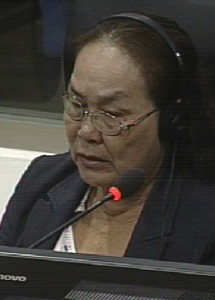
Civil Party Soy Naroeun
She became pregnant. She was required to work despite her morning sickness. She did not have sufficient food to eat. She missed her husband – who was working at a different worksite – when her morning sickness became severe. “My pregnancy was not of my decision or planning, but it was the target of Angkar.” She did not want to become pregnant, because she did not know what would happen to the baby once it was born. The baby did not survive. She had malaria when she was six months pregnant and when she was nine months and a few days pregnant, her baby died. She did not have any medicine to cure her malaria, which was why her baby died. “It was the policy for us to have babies.” This, she said, made her suffer.
Due to technical issues, around ten minutes of her testimony could not be heard in the media room and live stream.
The floor was handed to the Co-Prosecutors. Her husband told her that he was not aware of the arrangement. The chairman called her and told her that she was to marry a soldier who was handicapped at the battlefield. “I shouted at the time. I forgot about the risk of being killed and protested that I would not marry such a person.” Two months after her spontaneous refusal she was called again. The announcement was made to “bear as many children as possible, since Angkar needed people to defend the motherland.”
When her husband came to meet her after a week, they were allowed to spend the night together. “My feeling was that I did not want to live with him. However, since everything was over, I let myself go in a natural way as a man and a woman.”
While being pregnant, she sometimes vomited right after having eaten. She had to continue working, even when she was sick and emaciated. They were accused of being “psychologically sick” (which meant that they were accused of inventing their sicknesses). She later became pregnant again. This child survived.
No relatives attended her younger sister’s wedding either. She said it may have been worse for her sibling, since her sister got married in 1978 when living conditions were much harsher. She decided to remain in her relationship after the regime fell because of her child, who was born during the regime.
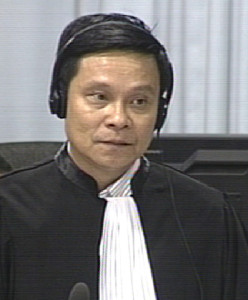
Nuon Chea Defense Counsel Liv Sovanna
It was then the turn for the Nuon Chea Defense Counsel to examine the Civil Party. Ms. Naroeun recounted that she was evacuated from her native village to another village in 1975. Mr. Sovanna pointed to her statement, in which she had said that she was transferred in 1974.[7] She replied that she could not recall the date clearly and that she built dam and dykes in 1974. When she arrived at the village, Phnom Penh was liberated after a few days. She got married during the windy season. Office S-62 had “many worksites”, she said. She protested, but she was told not to say anything. Comrade Moeun was in charge of the wedding. Chen was the chief, and Ren was the only female member. He was the top leader in S-62 district. She did not see the faces of the militiamen who took the couples away, since it was night time. She knew that the couples were newlywed, because they stayed in rooms that were only reserved for newlywed couples. Mr. Sovanna asked why she had not mentioned in her Victim Application Form that people were taken away. She replied that she remembered this later after filling out the form. Mr. Sovanna then wanted to know why she had not mentioned that 11 of her relatives lost her lives.[8] She explained that she had asked some organizations whether it was possible to file a supplementary information form about the loss of her relatives.
The Civil Party had two questions: Why did they use people like animals; and why did they have a law to force people to marry. The president informed her that the accused exercised their right to remain silent. He thanked her and dismissed her.
New Witness: Chuon Thi
Witness 2-TCW-859 fell into Category A of the OCIJ protection scheme. Throughout the day, there was a discussion about the exact meaning of this, since he had already previously testified until a Case 003 notice was cited that excluded him from the protection scheme. The lawyers could therefore use his name and other identifying factors. The witness was stationed in the West Zone. [9]
The floor was first handed to the Khieu Samphan Defense Team. Ms. Guissé asked about his role and position. He replied that he had indicated this in his first interview and that he did not have anything to add. Ms. Guissé asked whether he was promoted battalion chief after the liberation of Phnom Penh.[10]
He replied that he became a regiment leader after around three months. The commander of Division 1 was called Prak Soeun.[11] Ms. Guissé asked whether he received detailed instructions before being sent to Svay Rieng. He replied that he received instructions to bring Vietnamese to the border. Pol Pot called him to inform him about the border situation. Ms. Guissé asked whether anyone else was present during the meeting, and in particular Son Sen. He replied that there was Soeung and himself, but that he did not know Son Sen at the time. He gathered soldiers from the three battalions that were under his supervision. There were almost 1,000 soldiers. He instructed the forces to gather at a venue. The battalions communicated via messengers, since they did not use radio. They were used to gather the forces. The soldiers had been stationed along National Road 4.
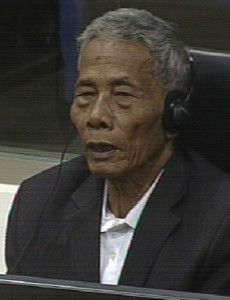
Witness Chuon Thi
Ms. Guissé wanted to know whether his forces were stationed at Prey Nob and Koh Kong.[12] He replied that his soldiers were not stationed in Koh Kong. He went to Svay Rieng with the soldiers from Prey Nob. The son-in-law of Ta Mok showed him the area. Ren told him to prepare themselves. A few people came with Ren. They dug trenches and prepared themselves for the “encroachment of those troops on our territory.” They did not see any civilians when they arrived at Svay Rieng. When he met with Pol Pot, the latter had not told him when the civilians had left Svay Rieng. [13]He did not know the commander of Division 703 and had only heard of his name through an announcement.
Ms. Guissé asked about Division 460; he had said that Phon was from Southwest Zone was the leader and Soy his deputy. He replied that he did not know them before, but had heard an announcement about the divisions. Ms. Guissé asked about Division 221 that he had called the Intervention Unit and said that Yeng Pan was the leader. He replied that he did not know their names. They were sent to take care of different spearheads. Ms. Guissé asked about his plan of attack that he had mentioned. He replied that it was developed with his combat forces. He said he was sure of how to implement his plan. He did not have time to meet Son Sen often. Two or three days after he arrived in Svay Rieng, they started to fight.
He did not know how many Vietnamese soldiers there were. They had a wide arrange of weapons. He controlled the infantry force. The artillery units and heavy weapons unit had other commanders.
Ms. Guissé asked whether the counterattacks came when he and his troops took the initiative to attack Vietnam.
At this point, the President adjourned the hearing for a break.
Conflict with Vietnam
After the break, the presiding judge Nil Nonn clarified the identity protection scheme for this witness. He said that an exception had been made and this witness did not have to remain anonymous. His name was Chuon Thi.
Ms. Guissé asked whether he ever received any information at the end of 1977 about a Vietnamese incursion into Cambodian territory. Before 1977, they talked about Vietnamese troops encroaching on Cambodian territory. Previously he was mainly tasked with working on the rice fields.
Ms. Guissé then referred to a speech of a Revolutionary Flag of April 1978.[14] Ms. Guissé asked whether he remembered having read copies of the Revolutionary Flag. He replied that the magazine did not talk about the fighting with neighboring countries. The excerpt talked about the troops at the border and their equipment. Ms. Guissé asked whether they had adapted their strategy to account for the disparity in numbers of Vietnamese and Cambodian soldiers and equipment. He replied that they could employ their own strategies, since it was Cambodian territory. For example, they could employ mines instead of fighting with soldiers. They said that in these situations they did not wait for plans from the center and that they had to individually decide upon their strategy without communicating. He learned these strategies since 1970s. [15] Ms. Guissé referred to a speech by Pol Pot, who had said that “don’t believe that we will never be able to conquer Vietnam”, just because the yuon had a million soldiers. Pol Pot had stressed that they were not allowed to be impressed by the number of inhabitants in Vitnam. He replied that Pol Pot was not at the battlefield and that they could not allow themselves to be overwhelmed, since they would be defeated then. They did not exchange information with surrounding units. “We could hear gunfire; we could see each other. Only once in a while, Ta Ren’s side would come.” Ms. Guissé read out an excerpt and asked whether he recalled telegrams talking about the enemy situation. He confirmed this. Ta Soeung forwarded it to him to disseminate it within his unit. `
He denied that his battlefield was at Preah Tonlé.[16] He did not know any of the names she had raised. Nor had he received instructions regarding them. Ms. Guissé read another excerpt of a situational report.[17] She asked whether he knew the locations east to Wat Bok Klang, Kok in Svay Rumpea. He replied that he was not there yet in October and that the Vietnamese had already arrived when he arrived there. He received the plan that mentioned that the Vietnamese had arrived in Svay Rieng but had already been pushed out. He did not receive information about previous Vietnamese incursions. He did not know about the situation in other units.[18] He did not meet the leadership of the other units. They were independent from each other.
Ms. Guissé then inquired about attacks by the Vietnamese. [19] “The leadership of DK did not have any policy to attack Vietnam, but because they had attacked us we had to attack them,” he said. “It’s like they enter our home, so we had to defend ourselves.” He and his force fled in 1979. Ms. Guissé wanted to know what he meant when he said that this story was “full of inexplicable links” that would occur if only looking at Democratic Kampuchea and not to the time before.[20] He replied that Democratic Kampuchea would be difficult to explain if one did not look at the time before.
He got married in 1976 in Longvek in Kampong Chhnang Province. He was stationed there first. His wife survived until today. “It was not forced. I proposed to the upper level and they organized the marriage for us.” However, it was not attended by his parents. His wife was an ordinary civilian.[21] “The relationship between men and women were not strict. They could interact with each other,” he said. “The marriage took place without any force. He had met his wife before and loved her, he said. The unit leader of her unit asked for permission.
The President adjourned the hearing. It will continue tomorrow at 9 am with the testimony of Chuon Thi, followed by witness 2-TCW-245.
[1] E3/9790.
[2] E1/262; E1/304.
[3] E3/9790, at answer 93.
[4] E3/9790, at answer 95.
[5] E3/9790, at answer 97.
[6] E3/6461, at 00546324 (KH).
[7] E3/5009, at 00559307 (KH).
[8] E3/5009.
[9] At 01321198 (EN).
[10] 24 April 2013, at 11:42.
[11] Ibid, at 9:46.
[12] E3/4953.
[13] E3/4593, at answer 15.
[14] E3/4604, at 00519835 (EN).
[15] E3/4604, at 00520348 (EN), 0064717 (KH), 00519836 (FR).
[16] At 00323727 (FR), 00185205 (EN), 00021015 (KH).
[17] E3/862, at 00814597 (FR), 000021019 (KH), 00185207 (EN).
[18] E3/4953.
[19] 24 April 2013, E1/183.1.
[20] E3/4593, at answer 20.
[21] E1/183.1, shortly before 10:03:30.
